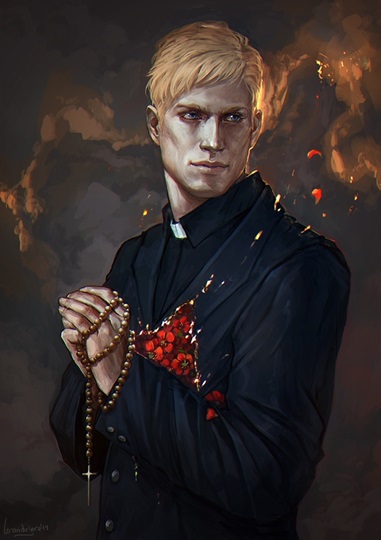We have begun our third adventure for Advanced Dungeons & Dragons, including one half-orc cleric-assassin for the Church of the Eternal and Fundamental Ordination, one half-elf fighter-assassin for the Church of the Ineffable Disruption of All Being, one half-elf fighter-thief who moonlights for the Disruption, and two half-orc fighter-clerics for the, well, it doesn’t really have a name, but anyway, it’s a little good god.
After the disorganized addition of players and characters, and a bit of “whatever, let’s try it” thinking for situations, I needed to activate some organizing principles: consequence and continuity, the characters aren’t a group, much less a party, and more weight to the city as an active and responsive place. Part 1 of doing so is to summarize who we know and what we know about them, as well as thinking about creatures who demand inclusion.
The “creatures” part is integrated with part 2, which involves rifling through books and files to find maps that seem to fit [who spots the ones I scanned from Sorcerers of Pan Tang?], thus working up locations in feedback with ideas. My governing notion, or specific goal, was to get more institutional regarding the big churches, as our focus had shifted a bit for the second adventure. I mean, the little shrine still commands a lot of attention, considering the “continuity” priority, but it’s only a bit of a big city.
Experience points had a big impact after the previous session, with leveling-up for three of the characters, double-classed for Marden Krown … as clerics and assassins have suspiciously identical level-up point totals, as yet another clue that at least one author, probably more than one, had a sneaky liking for this class combination.
I should explain these numbers a little bit. First, all characters began with 4002 experience points, because the fighter-combinations needed to have 2001 for 2nd-level Fighter. Back-extrapolating the rules for multi-class characters, that means the other class gets 2001 too, which is a bit “into” the requirements for 3rd level in all the others, especially Thief. Then you should be able to see how many XP were gained for the 1st adventure (Hazel, Marden Krown, Alexian Dusk) and for the 2nd (all the characters). Note the role of five 1000-XP magical items for a cool 1000 each … basically, without these, the level system in this version is unplayable.
Play was slow and scattered: short on time due to resolving the level-up numbers, and a bit hampered as Filip wasn’t there. Everyone ended up launched into doing something via a little bit of hard framing or a little bit of interaction.
I’m discovering a little residue of “we’re playing D&D so it must be like this” in my own head, without even being sure what that means. I don’t want to kill it and simply shift into how I’d play Sorcerer or whatever … there’s something present, perhaps in a 16-year-old’s mind from so long ago, that I’d like to understand better. Maybe I’ll get there with continued Musings.


10 responses to “Shady deeds in shadowy places”
SESSION 7
Clerics Assassins Fighters Thieves session 7 part 1 and some preparation notes, including maps.
Some computer hassles have kept me from editing and posting, but they are resolved and I have three sessions to catch up. This one continues with the five characters in various locations, in which I’m pushing the boundary of separated play which honors the passage of time across the locations.
This session marked the low point of real-time managing this sort of play, as I found it harder than usual; I think it gets better as the sessions continue. The key is knowing one’s NPCs, as I simply did better and managed to play actual events, thus shifting more easily to another person, when I had some (e.g., Milo’s fight with Vasth).

Here’s what Osmorn looks like:
I noticed a couple of errors involving damage and mayhem: when Alexian Dusk shattered the skeleton, I forgot about half-damage from edged weapons, although it might not have made a difference in that case; and when the fireball torched the square, the villagers seem not to have been incinerated by it, so I figure some must have been, so I’ll showcase it in later events.
Here are two more musings as well! #9 concludes the run-up of #6-8 regarding levels as a play-feature in this game, followed by #10 which is about hit points.
SESSION 8
I’ll rate the previous session and this one as real struggling for me, in playing the characters across many locations. There must be some psychological block involved, as it’s no problem at all in other games.
Here’s the session inside the playlist, my preparation notes for it, and a list of new NPCs. For anyone who’s understandably confused:
– Horc and Alexian are paying a friendly visit to the nearby sinister temple which looks more like a family mansion, discovering that its undead hive is only the beginning of its horrors.
– Hazel is burgling a tower, home to what is almost certainly a highly politically connected medusa, with her enthusiastic henchmen who don’t seem to understand “death is imminent.”
– Robert is dueling a locathah captain in a wind-swept battle as trebuchet and catapult missiles arc overhead.
– Marden Krown is investigating a chaos beer prank or op in the neighborhood he’s been assigned to as a new priest, but his biggest problem is his very, very Good new partner.
More musings as well: hit points regarding multi-classes, and the key issue of how these texts are written, i.e., full of confrontation and anger.
SESSION 9
Direct link into the playlist
Here we see some closure to the primary hassles faced by each character, with the exception of Hazel, whose situation finally begins its action. But unfortunately I think I’ll always look at this adventure, collectively speaking, as draggy play and a necessary lesson about this game, specifically, across multiple locations. It can be done well, but viewing this session especially shows you a basic failure.
I quite liked all the fights, and that my sympathy for Gorko was not mine alone, and that using the rules for the Wand of Wonders effectively as a monster turned out to be a great idea.
Some of the NPCs are taking better shape now, most of all Olver and Osmorn, but many others too.
My musings about treasure and experience are relevant here, because so few of the opponents either had treasure, or if they potentially did, I rolled so sparsely for it. The single exception does not escape Hazel’s grabby fingers, amazingly. But I’m also deciding that I should stop managing and strategizing experience points and levels, and focus on this play at this time with these characters and these threats, “inside” the current level so to speak.
Finally, I call your attention to the mighty tirapheg, which I quite liked playing although I wish the reaction roll had fallen harder toward one of the extremes.

SESSION 10
Preparing for this session was a little confusing, as it appeared that one player wouldn’t be there but was, another would be but wasn’t, and a third wouldn’t and wasn’t. So I concentrated only on Marden Krown, in his somewhat investigative city-streets adventure, and on Alexian Dusk, handwaving Horc to have left the premises quickly to do something important. The latter was a bit worrisome as I knew the nearby Center for Universal Munificence was striking at our little good god, but Robert (who’d triggered this by scaring the Golden Void guy) wasn’t there, so it would seem to come out of nowhere; also, what they had in mind was a hell of a lot of gun for just one player-character to face, even allied with evil baboons and good sprites.
Direct link into the playlist
Both characters’ situations moved along smartly, and I plan to zap all of them hard next time so that play won’t drag any more.
SESSION 11
Here concludes our multiple-situations “third adventure,” as I buckle down and punch all NPC play hard into wherever it would proceed from the events of the last session. In one case I added significant backstory content, but in all the others, they proceeded from first-principles content I’d put in place from the start, sometimes with details added as preparation along the way, sometimes not. I like the way that “goodness” continues to be the core thematic issue, and indeed a source of considerable headache for everyone else, whether within the Ordination or as a guiding principle as with the Little Good God. Here are the preparation notes.
Horc and Alexian dealt with the incursion and absorption from the nearby Center for Universal Munificence, which was instigated a while ago by Nil Mivig’s unfortunate reaction roll toward Robert – who wasn’t present in this little situation, so our heroes were puzzled as to how this ever happened. I am sad to have initially misunderstood the cifal rules, realizing it only in application at the table. Marden Krown navigated a tricky path between the racketeering boss Loorimax, upstanding and feared local benefactor of the Church, and his idealistic Lawful Good colleague, Osmorn. Hazel stole a valuable thing from a medusa and has inadvertently upset city politics. Robert fought a devil, invoked his god, and almost died (below 0 hit points).
Alignment is obviously the relevant game-device, so here’s Musing #13 to consider the general concept, to be followed by another that’s specified to this particular game.
Experience for the events of the past six sessions is more than tricky; it requires some basic rules-making given the various instructions or scoldings scattered throughout the Players Handbook and DM Guide. They didn’t operate as a “party” and in most cases were in solo situations, or in one case, a duo; therefore, all the experience points should be compartmentalized. Henchmen were involved to some extent in two of them, so the points for characters should be diminished in some way – although the rules for doing so seem to me to be one of the punitive deflationary practices that goes too far. Whether Robert technically defeated the bone devil is a good question; insofar as he used a resource he actually did have, I think so. The iron flask is listed as having no experience point reward or even resale value (?!), which as a feature of a magic item is otherwise applied to cursed and other booby-prize items … it seems most sensible to me to appraise what’s inside it (known to me), encountered or not. If I’m not going to be punitive about what the Thieves Guild would pay for it, then I can simply set the gold pieces value as equivalent.
Anyway, the point is that taking a legalistic approach to play law-student status games with self-appointed experts, or thinking that these books must be profoundly powerful if I could only “read them right,” are a mug’s game. I’m finding what’s fun for me to play in them, that’s all. However, I do find myself constrained in my thinking that somehow everyone should be getting about the same points, which raises some bigger issues about being overly-concerned about the broader, longer scope of play.
Here’s Musing #14 to continue my thoughts on alignment, as it applies to our game specifically. To review, Hazel (fighter-thief) is Chaotic Neutral, Alexian Dusk (fighter-assassin) is Chaotic Evil, Marden Krown (cleric-assassin) is Lawful Evil, and Robert and Horc (both fighter-clerics) are both Neutral Good.
As well as Musing #15, regarding “milieu” and notions of setting. Whose milieu is it, anyway? The books go around and around this question, and you have to choose which of the voices to listen to.
Here’s the final musing, #16, for this sequence of play. It’s a big deal. The more I think about it, and the more I continue to play Advanced D&D – as opposed to stalling out and socially melting down, which is what I knew to absolutely characterize its play 40+ years ago – the more I realize that the text, the discourse, the design, and the very concept is scaled too high. Level to level to level, especially: so much attention to who levels up when, for how much, whether you get too much along the way, how you get it, who dies when, how the risk mitigated or the event is recovered from, whether you deserve it … all at a scale far above, much longer, than the actual experience of play in a session.
Is DMing about play or about curating play? That’s the question at hand. If it’s the former, then can I set aside those higher-level considerations at least for a while, to focus on enjoying what we are playing inside this particular profile of character levels and available content? And if I do that, when I return my attention to the higher scale – because my job includes the backstory and much content of the next situation – do I find that I’m managing it, rather than merely doing that job? The texts are obsessed with managing it. That’s a problem.
I appreciate the personal, emotional reaction to the game you show in these musings. There’s evident frustration in some of them — when you have to assure the viewer that yes, you have read all the rules around alignment languages and you’re familiar with the debates, for instance. I can’t separate AD&D from its community, and neither can you, it sounds like.
I left the AD&D community because I got too frustrated having debates about rules interpretations. (I probably don’t have to describe the tenor or contents of these debates. It’s obvious to anyone with experience of them.) They got in the way of playing. The only productive way I could engage with AD&D was to make my own game, that smelled a lot like AD&D, and drew in everything about it I found compelling, but ditched the rest. In hindsight, almost everybody else was doing the same thing, but they would never admit it.
AD&D’s textual style left its mark on me. I *still* approach a new game as an archeological exercise. I can’t just read a bit and play and figure it out, I have to study the whole thing and get behind every detail. I’m working on it.
Anyway, once you push past all the bullshit, is the game any good for your purposes? Are you having fun?
The narrowing in focus for race and class has worked wonderfully. Once past the romantic notion that these texts have a grand vision unifying them, as they definitely do not and as I’ve known for decades, then one can address the play-opportunities in the parts being used. I like doing it with these texts because they are the last gasp of simply having tons of fantasy inspiration without it being “D&D as genre, the thing as we do it,” no matter how much textual torture is devoted to claiming that’s so. The components are blocky and ill-fitting, even inside the chosen pieces for play, which in a lot of ways is a good thing.
I leave it to anyone to assess the fun by watching the play videos, where I at least think it’s evident. As always, I haven’t sanitized it into a smooth performance, but have include a lot of the cross-text page-flipping and commentary, so you can see us actually work out what we want to do.